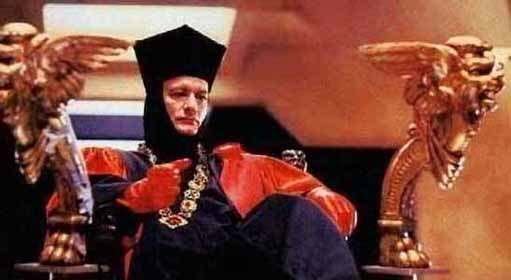The Opulence Of The US Supreme Court
I've watched enough Star Trek and StarGate episodes to know, when it comes to judicial systems on planets out there in the Great Expanse.
They are, for the most part, fucking weird.
Lots of guys wandering around with Hooded Monk Robes, chanting.
And lots of very spooky behaviour.
Sometimes colorful and sometimes all black and sombre.
But always Majestic and always one penny short of a Merlin the Magician moment.
Q from Star Trek springs to mind, when I think of a Judge ruling somewhere, out there, in a Galaxy Far Far Away
(Not to be confused with the Off The Fucking Wall Q-anon that has somehow Brain Snatched a large swathe of the MAGA crowd.)

Imagine my surprise, when I read an article about The US Supreme Court in which Q would feel right at home.
The Shakespearean drama. The stage like entrance of the Magnificent Ones.
It blew me away.
I was used to the Wigs on the British Judges and that to is over the top dramatics.
But the description of the American Supreme court was an eye opener.
A Supreme court Judge. A Job for life. Delivering down judgements that will affect millions of Americans and in lots of cases the rest of the world.
If ever we needed a Q, its now. The Q in Star Trek was a bit of a trickster.
But I'd take him in a heartbeat.
Anyway, below is the article about The Supreme Court of the U.S.A and how it is setup.
In case like me, you have an interest in these kinda things.
Read On:
Article by: David A. Kaplan
Secrecy and speechifying, collegiality and hierarchy, exceptionalism and opulence on the Supreme Court.
Nine mornings after Antonin Scalia died at Cíbolo Creek, the justices resumed work without their beloved, blustery colleague. The rich traditions of the Court continued unabated.
After the justices all shook hands in the small robing room across the hallway from the back of the courtroom, they lined up to await the gavel of the marshal.
The assembled throng grew silent, then arose. “Oyez! Oyez! Oyez!” the marshal chanted at the stroke of 10, as always. The eight justices emerged from behind the tall crimson velvet drapes and somberly took their upholstered swivel chairs on the bench.
“All persons having business before the Honorable, the Supreme Court of the United States,
are admonished to draw near and give their attention, for the Court is now sitting,” the marshal continued.
“God save the United States and this Honorable Court!”
It’s an opening worthy of “Hail to the Chief,” the introductory anthem for the leader of another branch of the federal government. It’s all carefully choreographed.
The justices don’t merely walk in, and they’re not already seated when Court begins.
From different curtains, they materialize in unison, in three groups based on where they sit.
As institutional stagecraft goes, the Court puts on quite a show.
At the corner of East Capitol and First in Washington, D.C., across the street and a world away from the workaday Congress, resides the Court.
Its proximity to Congress serves as a reminder of the looming power of the third branch of government. Built on the site of a prison for captured Confederates — the prison held Mary Surratt, Samuel Mudd and others arrested after Abraham Lincoln’s assassination — the Court is the closest thing we have to a secular shrine.
When its cornerstone was laid in 1932, amid the Great Depression, Charles Evans Hughes, the chief justice, proclaimed, “The Republic endures and this is the symbol of its faith.”
The Court is the most powerful in the history of the world.
In the old days (before heightened security screening), you entered by first walking up 44 broad majestic steps and then passing through two 6 1/2-ton sliding bronze doors centered behind columns of the front portico. High above the entrance, engraved across the facade, are the words equal justice under law. Inside, at the end of the Great Hall on the main floor, the courtroom is as magnificent a setting as exists in American government, a testament to the splendor of Italian and Spanish marble. The Oval Office at the White House is relatively small, decorated with furniture arranged on a human scale. By contrast, the gold-trimmed Supreme Chamber is a tableau of grandiosity — 82 feet long by 91 feet wide, flanked by massive windows and 24 columns, with richly colored coffers in the four-story-high ceiling. It’s no wonder that for decades they had a problem with echoes during oral arguments.
Above the columns are friezes depicting such historic lawgivers as Moses, Confucius and the Prophet Muhammad.
On the elevated Honduran mahogany bench, the chief sits in the middle, with the eight associate justices alternating by seniority on both sides.
(The most senior justice sits to the chief’s immediate right, the next most senior justice sits to the chief’s immediate left, and so forth.)
Since 1972, the bench has formed a crescent so that justices can better see each other. Overlooking the bench is a stately clock with Roman numerals.
The gates to side corridors are in sparkling bronze latticework.
Each justice gets a pewter mug of water and a porcelain spittoon that now serves as a wastebasket.
Read the Whole Story:
https://longreads.com/2018/09/06/above-it-all-how-the-court-got-so-supreme/
Image Courtesy of Quora